The Kaoss Pad

When the Kaoss pad KP1 was launched in 1999 is was a new and exciting way to use effects. It hosts a square touch panel that is sensitive to the figure and can be used to control effects in real time. It also has a built in single sample memory that allows the user to record and manipulate in a number of ways.
The Kaoss pad works as an all in one sampler, effects processor and tangible midi controller for audio and musical instruments. It allows the user audio control in real time over effects, samples and records. The player can control how effect is used and the amount by placing a single fingertip upon the tangible square surface. The parameters of effects are controlled completely using the x and y coordinates on the pad. Ruling both horizontal and vertical directions means that it is possible to control the effect time by stroking right, whilst simultaneously a downwards stroke can have power over the amount of feedback on the effect, these work instead of faders. By tapping lightly on the kaoss pad works like a switch and can control the effects, on and off. The benefit of having a touch screen x-y calibration instead of sliders, faders and knobs means that the koass pad can be small, light, compact and easier to use.
The kaoss pad contains effects such as;
Reverb
Delay
Pitch shifter
Sound processing filters
Modulation effects such as
Flanger
Chorus
Panning
Phaser
Ring modulation
The pad also allows the user control over sampling, and records from a source like CD to the pad for a maximum or five seconds at 48 kHz. The sample can then be used with the koass pad and modified using the effects available. This feature allows the player to intragrate sampled effects into a live set. The Kaoss pad also allows the user to connect a microphone and operates though a Jack. By singing or playing into the microphone allows the user to manipulate and sample the incoming signal in real time.
Since the KP1, Korg have developed and updated their products such as;
KP2 and the KPE2 (Kaoss pad enhancer) a kaoss pad that controls and manipulates both audio and video
KP3
Mini-KP, in the spring of 2008 Korg developed the last in the chain of kaoss pads the Mini-KP a smaller version of its brother the KP3, this kaoss pad hosts 2 memory banks, 100 new effects and holds 4 AA batteries. Making it safe to circuit bend and manipulate internally.
Personally I am not a fan of the chaos pad, and because of its natual ability to easily make alot of noise, it makes it hard to use well and effectivly, given to the wrong person the chaos pad can be a little bit overwelming.
A example of somone using the chaos pad 3 well is Beardy man, he uses his voice to make loops and samples of words aswell as beat boxing, conbineing it with drum samples stored within the memory of the chaos pad. He also using a vocodera and other effects such as chorus, delay and reverb. You can see in the video how he is using his fingure of the touch pad to manipulate diferent aspects of the music he creating.I think this is very effective and I enjoyed watching it. Beardy man makes it look easy and fun to use a chaos pad.
http://www.youtube.com/watch?v=39n4wow8fWE








